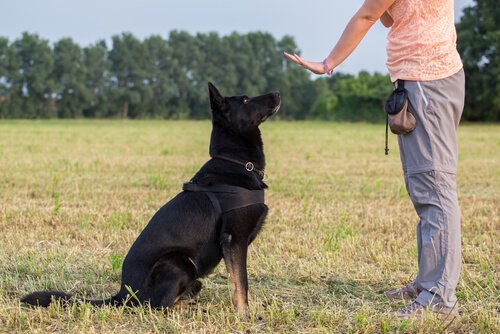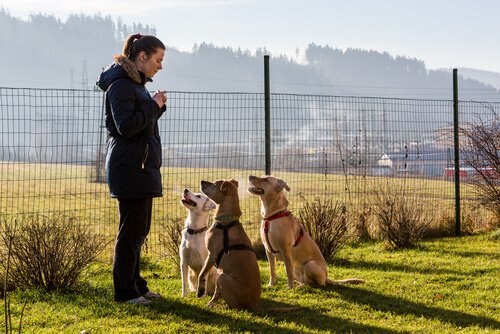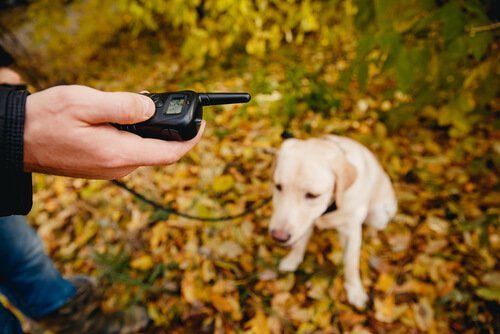What is positive dog training?

When your dog has a behavioral problem and you don’t know how to fix it yourself, you need the help of a dog trainer. Many of them call themselves positive trainers, but not everyone is clear on what that word refers to, so read on to learn all about positive dog training.
Training and handling
There are three types of professionals who work in the arena of canine behavior: trainers, handlers and ethologists.
- Ethologists are veterinary specialists in this field. They study and are familiar with the behavior of all animals on the planet, although the ones we see in clinics specialize in domesticated animals.
- Handlers teach dogs to obey commands no matter what situation they’re in. For example, it is a handler’s job to train drug-sniffing dogs. Once the dog has learned the command, he will act the same no matter if the command is given in an airport or at home, in a crowd or alone.
- Trainers address behavioral problems. They look into the dog’s life to find out what motivates him to do whatever it is his family considers a problem. Then they find the root issue and address it.

These three professions are similar but very different at the same time. Each one is specialized to achieve the best results for each specific case. As in many other professions, there are many different approaches. “Positive” is one, and we’ll look into it now.
The history of dog training
This division of professions is relatively recent. The role of handler emerged less than 100 years ago and became oriented towards training about 50 years ago. However, the profession of ethology, where ethologists are specialists in animal behavior, has been around for longer. At first, though, they focused on wild animals.
Dog handlers and trainers began working with dogs using force. For example, those who worked with dog actors used punishment and pain to teach dogs what to do. In other words, the dogs worked to avoid the consequences of disobeying orders.
Soon after, a more respectful technique was discovered. It taught dogs faster too. Instead of punishing them, trainers gave them rewards for good work, thus inciting the dogs to work or behave well without having to reprimand them. This technique is used today in the training of many other animals, like for dolphins in aquarium shows.

According to the laws of learning formulated by Skinner, these rewards are called positive reinforcement. Handlers and trainers who traded punishment for positive reinforcement began to be called “positive” trainers.
The label “positive dog training” is overused
Positive training is oriented towards not harming the dog. Punishment harms dogs, whether physical, like whipping with a belt and kicking, or psychological, like shouting and isolating.
On the contrary, positive dog training motivates the dog to behave well and rewards him when he does. The dog obeys because he wants to and because he inherently wants to please humans.
Those who continued to use punishment and pain were then often called “traditional,” while those who sought to work with dogs respectfully were called “positive.” Despite the clear difference, the terms soon began to mix.
Few families want to take their dog to a professional who is going to hurt him. Therefore, the “traditional” professionals began to incorporate rewards into their process. However, they didn’t completely do away with punishment.
Today, many handlers and trainers mix the two techniques: they reward and punish. They motivate the dog to work in exchange for rewards and so that they will not be punished.
That’s why we say the label is overused: just because a handler calls himself “positive,” it doesn’t guarantee that he won’t intimidate or hurt your dog. It has become the responsibility of owners who are looking out for their dog’s best interest to make sure that his trainers are treating him with respect.
Pain as a cause of behavioral problems
It has become clear that the use of positive reinforcement accelerates learning and problem-solving in any kind of animal. Punishment, though, confuses the dog and keeps him from learning. The use of pain strains the relationship between dogs and their human families. They associate pain with the new behaviors they are to learn.
Spiked, electric and choking collars also fall under this category. It has been shown that these techniques only mask problems — it does not solve them — and make dogs unstable and unpredictable.

You want your dog to be happy and behave well because he wants to, not because he fears you. Only pain-free and fear-free training can achieve this goal.
How to choose a good professional who uses positive dog training
Since the label “positive dog training” has been tainted and no longer guarantees that only positive reinforcement is used, you will have to do your due diligence. Before hiring someone, talk to him, ask him questions, and only continue with him if you trust him.
In short, make sure your dog trainer:
- listens to you and respects you, your dog and your problems.
- does not pull on the leash, push, or strike the dog.
- offers solutions and guidelines adapted to your particular case.
- does not use spiked, choking, electric or noose collars.
- does not base his work on the theory of dominance, but rather on scientific evidence.
When your dog has a behavioral problem and you don’t know how to fix it yourself, you need the help of a dog trainer. Many of them call themselves positive trainers, but not everyone is clear on what that word refers to, so read on to learn all about positive dog training.
Training and handling
There are three types of professionals who work in the arena of canine behavior: trainers, handlers and ethologists.
- Ethologists are veterinary specialists in this field. They study and are familiar with the behavior of all animals on the planet, although the ones we see in clinics specialize in domesticated animals.
- Handlers teach dogs to obey commands no matter what situation they’re in. For example, it is a handler’s job to train drug-sniffing dogs. Once the dog has learned the command, he will act the same no matter if the command is given in an airport or at home, in a crowd or alone.
- Trainers address behavioral problems. They look into the dog’s life to find out what motivates him to do whatever it is his family considers a problem. Then they find the root issue and address it.

These three professions are similar but very different at the same time. Each one is specialized to achieve the best results for each specific case. As in many other professions, there are many different approaches. “Positive” is one, and we’ll look into it now.
The history of dog training
This division of professions is relatively recent. The role of handler emerged less than 100 years ago and became oriented towards training about 50 years ago. However, the profession of ethology, where ethologists are specialists in animal behavior, has been around for longer. At first, though, they focused on wild animals.
Dog handlers and trainers began working with dogs using force. For example, those who worked with dog actors used punishment and pain to teach dogs what to do. In other words, the dogs worked to avoid the consequences of disobeying orders.
Soon after, a more respectful technique was discovered. It taught dogs faster too. Instead of punishing them, trainers gave them rewards for good work, thus inciting the dogs to work or behave well without having to reprimand them. This technique is used today in the training of many other animals, like for dolphins in aquarium shows.

According to the laws of learning formulated by Skinner, these rewards are called positive reinforcement. Handlers and trainers who traded punishment for positive reinforcement began to be called “positive” trainers.
The label “positive dog training” is overused
Positive training is oriented towards not harming the dog. Punishment harms dogs, whether physical, like whipping with a belt and kicking, or psychological, like shouting and isolating.
On the contrary, positive dog training motivates the dog to behave well and rewards him when he does. The dog obeys because he wants to and because he inherently wants to please humans.
Those who continued to use punishment and pain were then often called “traditional,” while those who sought to work with dogs respectfully were called “positive.” Despite the clear difference, the terms soon began to mix.
Few families want to take their dog to a professional who is going to hurt him. Therefore, the “traditional” professionals began to incorporate rewards into their process. However, they didn’t completely do away with punishment.
Today, many handlers and trainers mix the two techniques: they reward and punish. They motivate the dog to work in exchange for rewards and so that they will not be punished.
That’s why we say the label is overused: just because a handler calls himself “positive,” it doesn’t guarantee that he won’t intimidate or hurt your dog. It has become the responsibility of owners who are looking out for their dog’s best interest to make sure that his trainers are treating him with respect.
Pain as a cause of behavioral problems
It has become clear that the use of positive reinforcement accelerates learning and problem-solving in any kind of animal. Punishment, though, confuses the dog and keeps him from learning. The use of pain strains the relationship between dogs and their human families. They associate pain with the new behaviors they are to learn.
Spiked, electric and choking collars also fall under this category. It has been shown that these techniques only mask problems — it does not solve them — and make dogs unstable and unpredictable.

You want your dog to be happy and behave well because he wants to, not because he fears you. Only pain-free and fear-free training can achieve this goal.
How to choose a good professional who uses positive dog training
Since the label “positive dog training” has been tainted and no longer guarantees that only positive reinforcement is used, you will have to do your due diligence. Before hiring someone, talk to him, ask him questions, and only continue with him if you trust him.
In short, make sure your dog trainer:
- listens to you and respects you, your dog and your problems.
- does not pull on the leash, push, or strike the dog.
- offers solutions and guidelines adapted to your particular case.
- does not use spiked, choking, electric or noose collars.
- does not base his work on the theory of dominance, but rather on scientific evidence.
This text is provided for informational purposes only and does not replace consultation with a professional. If in doubt, consult your specialist.








